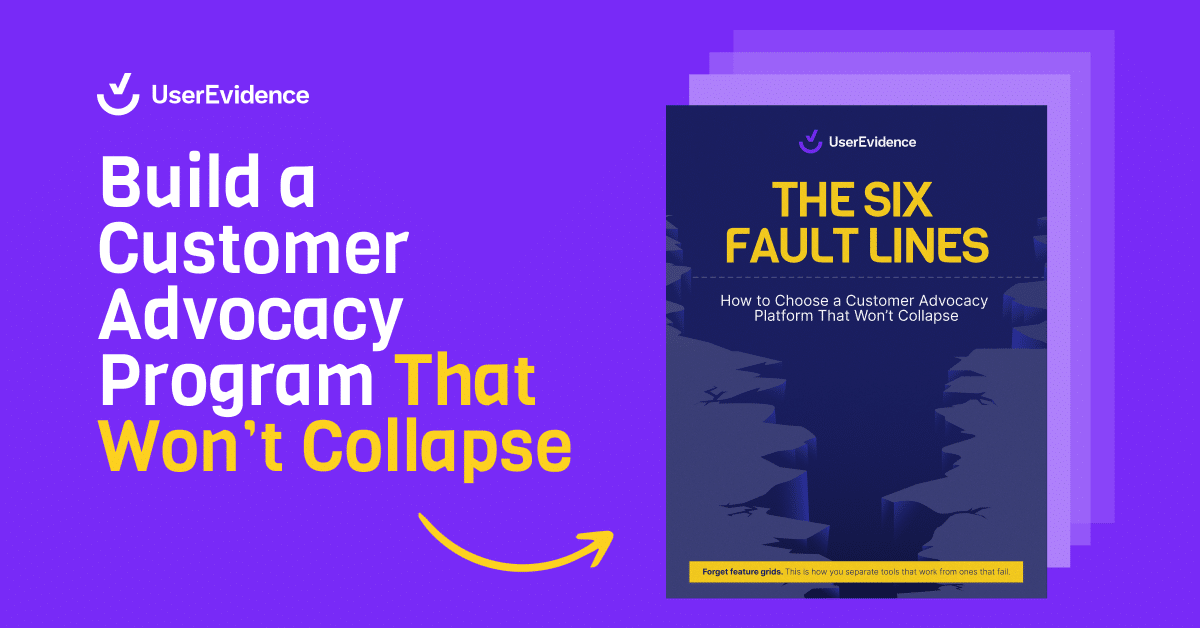TL;DR
Grammarly didn’t scale customer storytelling by cranking out more case studies—they scaled it by building a system. One that’s flexible, efficient, and so ingrained in how GTM runs that every team can tap into it instantly. Here’s how they did it (and why trying to DIY it without a tool like UserEvidence is a fast track to failure):
Here’s what we cover:
- How Grammarly reframed what a “customer story” even is
- The system behind scaling content without adding headcount
- How centralizing content made GTM self-serve customer proof (and took the marketing team off of the hamster wheel of requests)
- What most teams get wrong about building a customer evidence program (and why Grammarly didn’t)
- Irena’s blunt advice for teams trying to duct tape together a solution
Let Grammarly’s approach be your blueprint—and your warning. Scale starts with systems, not scrambles.
As I sat down with Irena Kin, Grammarly’s Product Marketing Business Strategy Director, outside of a San Francisco café a few weeks ago, we laughed about having both faced this similar scenario in our careers:
Sales: needs a customer story to move a deal over the finish line; asks marketing if we have it.
Marketing: says we don’t have it.
Sales: asks what we can get together, quickly.
Marketing: scrambles to work with Customer Success to find a good customer to grab a quote from.
Sales: asks when they’ll have the quote.
Customer Success: finds the customer; grabs the quote; gets stuck in a back-and-forth with customer’s comms/legal team trying to get approval to use the quote
Sales: asks marketing when they’ll have the quote
Marketing: *bangs head against wall*
On the off chance you don’t know, Grammarly is a leading AI communication assistant used by more than 40 million people every day (yes, seriously) and 50,000 companies, including Atlassian, Databricks, and Zoom. And even in a company of that scale–Irena used to feel this scenario play out.
This is how most GTM teams approach customer evidence, we both agreed. It’s reactive. It’s chaotic. It’s filled with tension between teams and scrambles for half-baked proof points that might move a deal along.
But here’s the bigger gut-punch about this scenario: these scrambles don’t just waste time—they limit your ability to scale what actually works: real customer stories that build trust and convert faster.
Most customer evidence programs are isolated, under-leveraged, and too slow to keep up with the modern GTM motions.
But Irena told me that’s not how they do it at Grammarly. They don’t create one-off case studies or customer stories anymore–they’ve already seen what’s at stake. They’ve built a powerful customer evidence program that has impacted every team across the company. How? They’ve proactively scaled customer evidence in 3 different ways:
- Making customer storytelling flexible (it’s more than just case studies and quotes)
- Making customer evidence creation scalable
- Making customer evidence self-serve
And, lucky us, Irena and a few of her teammates are sharing the details to this exact playbook with us today.
Making customer storytelling flexible
If you ask Irena what a customer story looks like, she won’t hand you a polished PDF with boilerplate copy and a three-part structure. Instead, she’ll tell you a story is whatever a team needs it to be: a one-line quote, a sharp metric, a persona-specific mini narrative.
“Customer story as a phrase is malleable. What makes a story successful shifts based on who’s using it and what they need it for,” Irena explains.

"Customer story as a phrase is malleable. What makes a story successful shifts based on who’s using it and what they need it for."

But here’s the thing: that’s not just what Irena believes. It’s the mentality that the whole org has adopted. And that shift in thinking? It’s changed everything.
Instead of producing static assets for one-off use cases, Grammarly adopted a modular approach to customer storytelling. They built assets that could flex: long or short, visual or written, standalone or stackable. This meant Sales didn’t have to waste time digging through irrelevant PDFs. PMM could support analyst conversations with long-form proof. And Marketing could use snippets in social campaigns or launch decks.
Even more important? That flexibility preserved the human element.
“You start to lose the uniqueness of the story…the stories of the people that made the implementation successful. That’s what inspires others,” Irena adds.
Grammarly didn’t want a content factory. They wanted storytelling infrastructure. So, they built it.
Making customer evidence creation scalable
Flexibility only works if you can produce content at scale. But like most B2B companies, Grammarly runs lean. They needed to create quality assets quickly—without blowing timelines or overloading teams.
That’s where UserEvidence comes in.
“UserEvidence is our content repository. It’s our engine for scaled storytelling. It’s the way that we uncover new stories or new advocates,” Irena says.
Enter Elyssa Hines, Grammarly’s Customer Marketing Manager, who operationalized the entire program. She’s not just taking requests for new evidence–she’s leading the charge herself.
On a repeatable cadence, she leads strategic outreach—either to targeted customer segments or via broader campaigns—to gather raw input.
Sometimes it’s sending out a survey from the UserEvidence in-platform surveying tool, other times it’s surfing the latest third-party review sites (like G2) to see if there are any testimonials worth pulling into their library.
All of that feedback—whether it comes from the survey or third-party sites—flows directly into UserEvidence, where it’s curated, tagged, and transformed into versatile, on-brand assets like slides, quote graphics, or ROI stats.
“The platform lets us quickly turn that input into polished, digestible customer proof without requiring a heavy editorial lift,” Elyssa explains.
The results speak volumes:
- 700+ ready-to-use assets in their library
- 4–8 hours saved each week
- Near-instant turnaround for content requests
- No reliance on design or creative
- A centralized, searchable content hub
Instead of gathering input in one place and producing content in another, everything happens within one system. No disjointed workflows. No delays. Just usable, high-quality proof points that show up where GTM teams need them.
“You need a strategy, and you need to pay attention to it. We hired someone to make UserEvidence and our customer evidence program more successful,” Irena says.
Making customer evidence self-serve
Most companies think creating the content is the hard part. But what about actually using it?
Grammarly solved for that, too.
With UserEvidence, they built an internal library that’s fully accessible to every go-to-market team. Sales reps can grab industry-specific proof mid-deal. Comms can pull quotes for media briefings. Product marketers can filter by feature or persona. There’s no gatekeeper.
“If a customer story is worth the effort it took to get it, it’s being used by everyone—sales, product, marketing, the executive team. It’s the currency of the company,” Irena says.
Grammarly’s VP of Product Marketing, Alex Gay, feels this firsthand.

“At Grammarly, collecting and sharing customer insights is integral to our strategy and showcases our commitment to our customers. By leveraging UserEvidence, we efficiently transform raw customer feedback into compelling customer proof. This approach reduces our editorial workload while maximizing authenticity and highlighting our customers’ voices.”

With everything centralized, usage becomes natural across all teams. The more the marketing team started using the self-serve library to surface the customer evidence they need, the more notice the rest of the GTM team took–and the more they adopted it themselves.
“From social and comms to demand gen and product marketing, team members can find and use relevant content without reinventing the wheel,” Elyssa adds.
Final takeaway: Build the system before you scale the stories
As Irena and I wrapped up our conversation outside of that San Francisco café, I shared with her that a common objection our sales team faces is that teams feel they can build and scale a customer evidence program just as effectively without investing in a tool like UserEvidence. She immediately leaned forward, and literally yelled:
“If you have Qualtrics and SurveyMonkey and think you can do this yourself, you cannot. DO NOT try to DIY this! You will FAIL!”
(Clip here for proof—I bring the receipts.)
It made me laugh—and also validated everything we believe about how hard this is to do right..
Grammarly didn’t build a customer evidence program just to create content. They built a system that makes storytelling part of how their entire GTM engine runs.
They proved that a small, focused team can build big impact—if they commit to:
- Adopting a flexible mindset about customer stories
- Streamlining the creation process with the right tool
- Giving every team access to customer proof
But as she reminded me, most teams can’t scale beyond a handful of stories without adding headcount or losing consistency. UserEvidence gave Grammarly the leverage to do both.
Customer evidence isn’t just a sales tool or a marketing asset. At Grammarly, it’s core to how they operate.
And now, they can’t imagine running GTM without it.
FAQs About Scaling Customer Evidence Programs
What is Grammarly’s approach to customer storytelling?
Grammarly redefined customer stories as flexible, modular assets rather than static case studies. Instead of lengthy PDFs, their GTM teams use quotes, metrics, and mini-narratives tailored to specific use cases—making the content more versatile and actionable across channels.
How did Grammarly scale customer evidence without adding headcount?
By leveraging UserEvidence, Grammarly automated much of the content creation process. They collect customer feedback via surveys and reviews, then quickly turn that input into branded, reusable assets—saving time and reducing reliance on creative teams.
Why is centralizing customer content important for GTM teams?
A centralized library makes customer proof self-serve, so Sales, Marketing, and Product teams can instantly find relevant stories. This eliminates bottlenecks, shortens content turnaround times, and encourages cross-functional adoption.
What do most companies get wrong about customer evidence programs?
Most teams treat customer stories as one-off assets, relying on manual processes that don’t scale. Grammarly avoided this by systematizing content collection and distribution, making customer evidence a core part of their GTM strategy.
Can teams really DIY a customer evidence program without a tool?
Grammarly’s team strongly advises against it. Without a platform like UserEvidence, teams struggle with inefficiencies, approvals, and content consistency—making it nearly impossible to scale or maintain quality.
How does flexibility improve the impact of customer stories?
Flexible storytelling lets teams adapt proof points to fit their specific needs—whether that’s a sales deck, social media post, or executive presentation. This adaptability drives higher usage and greater ROI from each piece of content.




